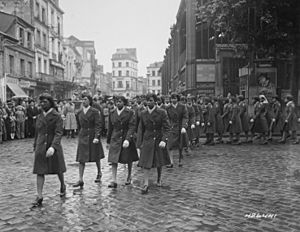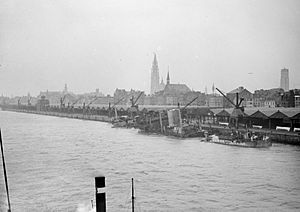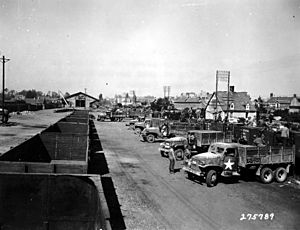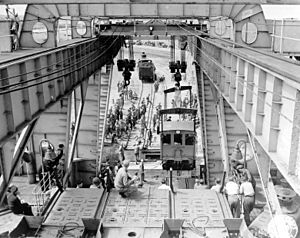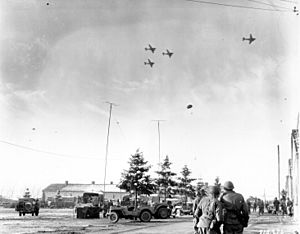American transportation in the Siegfried Line campaign facts for kids
During World War II, getting supplies to the American army was super important for the Siegfried Line campaign. This campaign happened from September to December 1944. The American army was chasing German forces, but this chase stretched their supply system to its limits.
The Germans tried to slow down the Allies by blocking ports and destroying roads and railways. This caused big transportation problems for the American forces in Europe. In September, Cherbourg was the only major port the Allies controlled. It was badly damaged and took a long time to fix. Smaller ports could only handle small ships.
More and more supplies came directly from the United States. These huge shipments often included heavy items that needed special cranes to unload. There weren't enough cranes or port space to handle all the ships arriving. This caused ships to wait a long time, leading to a big shipping problem.
To help, new ports like Rouen and Le Havre were opened in September and October. Then, Antwerp opened in November. Antwerp was big enough for all the Allies' needs. However, it didn't have much covered storage. American supplies were supposed to move quickly to depots near Liège.
At first, trucks moved most supplies. But as railways were fixed, they took over. Waterways like the Seine and Albert Canal were also used to ease the pressure on trains. Air transport was expensive but helped deliver urgent supplies when roads and railways couldn't.
Even with supply issues, the Allied advance also slowed because of tough terrain, bad weather, and strong German resistance. The Germans even launched a surprise attack called the Ardennes offensive in December. This put a lot of stress on the American supply lines. But by early 1945, the transportation system was much stronger, ready for the final push into Germany.
Contents
Why Supplies Were So Important
In the summer of 1944, after the Normandy landings, the Allies pushed the German army back. American forces, led by General Dwight D. Eisenhower, decided to keep chasing the Germans instead of stopping to build up supplies. This quick advance meant the supply lines became very long.
By September, the advance stopped. It wasn't just because of a lack of supplies, but because it was hard to get those supplies to the soldiers. Railways and pipelines couldn't be fixed fast enough. Trucks were used, but there weren't enough heavy-duty ones. Smaller trucks broke down easily from being overloaded and used too much.
Many vehicles were damaged or worn out. For example, hundreds of tanks and thousands of trucks and jeeps were lost each month. Mechanics struggled to fix them because of a lack of parts. Sometimes, supplies were just piled up without proper records, making it hard to find what was needed.
The Germans tried to delay the Allies by destroying transportation links and holding onto ports. They hoped this would buy them time to rebuild their forces. They also hoped bad autumn weather would make it even harder for the Allies to move supplies.
Getting Supplies by Ship
The original plan for the invasion, Operation Overlord, relied on ports like Cherbourg. But Cherbourg was heavily damaged. Bad weather also made it hard to unload ships on the beaches. The beaches were eventually closed in November.
Cherbourg was supposed to handle 20,000 tons of supplies daily, but it couldn't. Mines and obstacles slowed down repairs. Other ports like Brest were too damaged to use. This meant smaller "coaster" ships were crucial for moving supplies across the English Channel. About two-thirds of Britain's coaster fleet was used for the campaign.
Ships coming from the United States often carried vehicles in crates. These needed large cranes to unload, which were only available at major ports. In September, only 95 ships could be unloaded on the continent. Many ships had to wait at anchor, which was dangerous and wasteful.
The US War Department cut back on shipments to Europe because so many ships were waiting. General Brehon B. Somervell, who was in charge of Army Service Forces, even sent an expert to help improve unloading times. The problem was huge: hundreds of ships were sitting idle around the world.
To fix this, the US government decided to cut non-military shipments. They also pushed for faster unloading. Port workers were given incentives like extra time off for good performance. By February 1945, the unloading rate greatly improved, and the shipping crisis finally ended.
Ports: Gateways for Supplies
Minor Ports
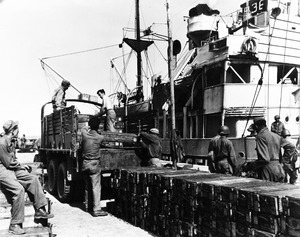
When major ports were hard to open, smaller ports in Normandy and Brittany were used. Many of these were far from the front lines and had limited capacity. For example, Granville was used mainly for coal. Other ports like Saint-Malo and Cancale were either too difficult to repair or had bad tidal conditions.
However, ports like Morlaix and Roscoff were quickly fixed. They handled thousands of tons of supplies daily until the bigger Seine ports opened. These smaller ports were important when bad weather made beach operations impossible.
Cherbourg
Cherbourg was a huge challenge. It was heavily damaged, and repairs fell behind schedule. The first oil tanker didn't unload until late July, weeks late. Deep-water berths for large ships were especially slow to open. It took until mid-December for all repairs to be completed.
Unloading ships was complicated. There needed to be enough workers, cranes, and trucks ready. Sometimes, ships arrived without proper lists of their cargo, making it hard to know what they carried. At first, the Navy wouldn't let these ships in, but they often had critical supplies.
Much of the cargo at Cherbourg was unloaded by DUKWs, which are amphibious trucks. This was slower and needed more people than unloading directly at the docks. DUKWs were also limited in what they could carry and were affected by bad weather.
Problems with cranes and skilled operators also slowed things down. Many cranes were out of action due to damage or lack of spare parts. The commander of the port was even replaced because of slow unloading. However, improvements were made, especially in coordinating port and rail operations. Cherbourg became very important for unloading ammunition.
Le Havre
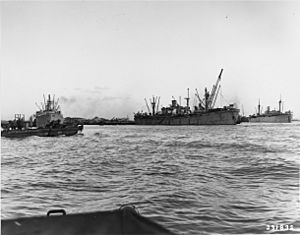
The ports along the Seine River, like Le Havre, were important. Le Havre was closer to the front lines than the Brittany ports. It had been the second-largest port in France but was heavily damaged by bombs and German demolitions.
Engineers worked quickly to make Le Havre usable. They built floating piers and repaired damaged locks. The first large ships could dock in October. Even with repairs, the port still relied heavily on DUKWs and lighters (small boats) to unload cargo. DUKWs were constantly breaking down due to overuse and lack of parts.
Despite the challenges, Le Havre exceeded expectations. By the end of 1944, it handled thousands of tons of cargo daily. It also became a major point for American troops arriving in Europe. In 1945, German prisoners of war helped with the work.
Rouen
Rouen, also on the Seine, was less damaged than Le Havre. Germans had destroyed cargo facilities and blocked the river, but many quays were still good. Engineers and the US Navy worked to clear the river and repair facilities.
Rouen started handling ships in October. It was very successful, especially for smaller ships. Its main problem was not enough workers or ways to move supplies away from the port by road or rail. Barges also started moving supplies from Rouen. The port also became a debarkation point for troops and vehicles.
Antwerp
Antwerp was one of the world's busiest ports before the war. It was captured in September 1944, mostly intact, thanks to the British army and Belgian Resistance. It was much closer to the American supply depots than Cherbourg.
However, the Scheldt River leading to Antwerp was mined and blocked. It took the Canadian army until November to clear it. Once open, Antwerp could handle all the Allies' needs. The port was shared between British and American forces.
Belgian workers did most of the unloading. However, German V-weapon attacks (rockets) on Antwerp caused many casualties and made workers move away. Strikes happened due to bad living conditions, but they were quickly resolved. Ammunition ships were banned from Antwerp because of the danger of V-weapon attacks.
Antwerp could handle huge amounts of cargo, but the main problem was moving supplies away from the port. There wasn't much covered storage space, and supplies piled up. The German Ardennes offensive in December made this worse, as rail and barge shipments to the depots were halted. Despite these issues, Antwerp became a vital supply hub.
Ghent
Ghent was another Belgian port, about 20 miles from the sea. It was captured in September but wasn't initially planned for use. However, the heavy V-weapon attacks on Antwerp made the Allies decide to open Ghent as a backup.
Ghent wasn't badly damaged, but it needed dredging to allow large ships. The first US ship arrived in January 1945. Ghent helped handle supplies, especially when Antwerp faced problems.
Moving Supplies by Road (Highways)
Trucks were the most flexible way to move supplies. They could go anywhere and respond quickly to changes. They were used for short trips around depots, clearing ports, and long hauls to the front lines. The famous Red Ball Express was a special truck route that moved thousands of tons of supplies daily.
Other express routes like the Red Lion, White Ball, and ABC Haul were also set up. These routes helped move supplies from ports to rail transfer points or directly to the armies.
However, there weren't enough heavy trucks. Smaller trucks were overloaded and broke down often. A big problem was a shortage of tires, as Japan controlled most of the world's natural rubber. Tires wore out quickly due to long distances and overloading. Efforts were made to repair and retread tires, and French and Belgian factories started making new ones.
The flexibility of trucks was shown during the Ardennes offensive. Thousands of trucks were quickly redirected from port duties to move troops, equipment, and supplies to the threatened areas.
Moving Supplies by Rail (Railways)
While trucks were flexible, trains could move much larger amounts of supplies over long distances. The railway system in northern France was crucial. Many bridges had been destroyed by Allied bombing or German demolitions. Engineers worked hard to repair them, often using British-made bridge parts.
The railway system improved steadily. Two main transfer points were set up near Paris where supplies from trucks could be loaded onto trains. This greatly reduced the need for trucks to make long hauls. By November, trains were moving over half the supplies to the depots. The Red Ball Express, the famous truck route, was eventually stopped because trains could handle the load.
A big challenge was the lack of trains and railway cars. Many French trains were destroyed or taken by the Germans. The US had to ship trains and railway cars from America. Captured German and Italian trains were also repaired.
Armies sometimes used railway cars as mobile warehouses, which tied up valuable rolling stock. During the Ardennes offensive, trains were used to move supplies away from threatened areas. Bridges were damaged again by fighting and air raids, causing more delays.
Moving Supplies by Air
Air transport was the most expensive way to move supplies, but it was used when roads and railways couldn't keep up. In September and October, cargo planes and even converted bombers delivered thousands of tons of supplies, mostly gasoline, to airfields near the front.
Bad weather often limited air operations. In December, air supply became critical for isolated units, especially the 101st Airborne Division cut off in Bastogne. Planes airdropped supplies to them, which was considered a success despite some losses.
Moving Supplies by Inland Waterways
Using rivers and canals for transport wasn't a main plan at first. But it became necessary to move coal to Paris and relieve pressure on railways. Four main waterways were fixed for military use: the Seine, Oise, and Rhône rivers, and the Albert Canal.
Engineers repaired locks and removed obstructions like demolished bridges. The Tancarville Canal was important for allowing barges from Le Havre to reach the Seine. The Albert Canal was especially useful as it connected Antwerp directly to the depots near Liège.
Barge traffic faced challenges like low bridges and freezing canals in winter. But eventually, barges carried a huge amount of cargo, especially on the Albert Canal, helping to ease the burden on other transportation methods.
The Outcome
Supply problems did slow down the Allied advance. But other factors like tough terrain, bad weather, and strong German resistance also played a big part. The American army had to stop when they met strong opposition.
As the Americans faced the German Siegfried Line, ammunition became more important than fuel. Even though the supply situation improved, the push to the Rhine in November was perhaps too early. The German army was able to launch the Ardennes offensive in December.
This attack put huge pressure on the American supply lines, especially the new port of Antwerp. But by the start of 1945, the American transportation system was stronger than ever. It was ready to support the final push into Germany.





